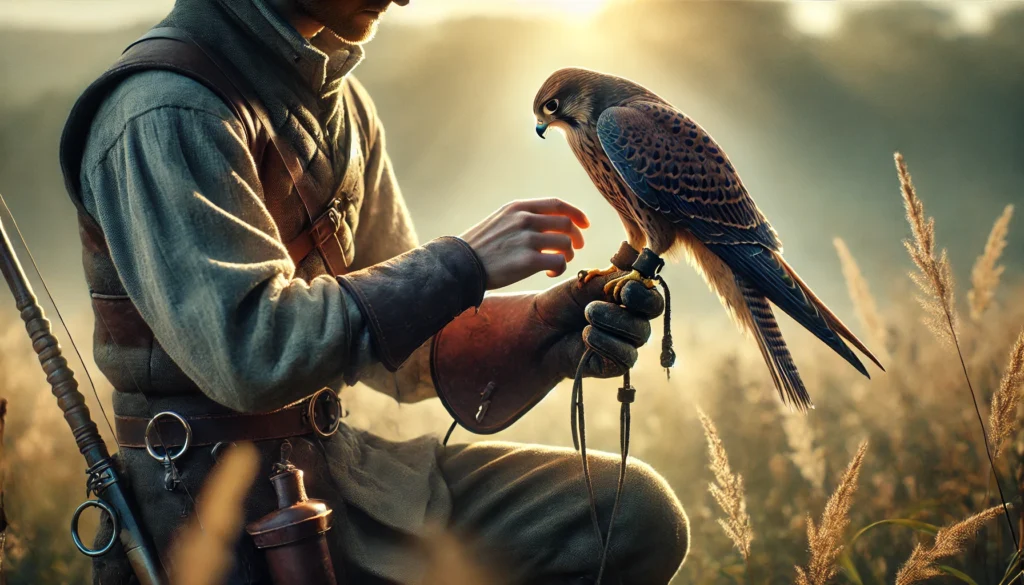Advances in Falconry
- Falconry is an ancient practice of hunting with birds of prey.
- New techniques and tools have made training falcons easier and more effective.
- Modern falconers use GPS trackers to monitor their birds’ location and health.
- Advances in veterinary care have improved the health and longevity of falcons.
- Conservation efforts are helping to protect wild raptor populations.
- Falconry is recognized as a sustainable form of wildlife management.
- Education and outreach programs are teaching people about the importance of raptors.
- Technology is creating new ways for people to connect with and learn about falconry.
Falconry is continuously evolving, blending tradition with modern advancements to enhance the experience for both falcons and falconers.
The Exciting Evolution of Falconry: Why These Advances are a Game-Changer
Hey there, adventurers and animal enthusiasts! Ready to take flight into the captivating world of falconry? At Learn Falconry, we’ve seen some incredible changes in the way people interact with these magnificent birds of prey, and we can’t wait to share them with you!
To make it easy for you, let me weave in a good old Irish analogy. Imagine the art of falconry as a traditional Celtic dance. Just like the dance, falconry involves coordination, trust, and a deep connection with history. However, with new strides in teaching techniques, equipment, and conservation efforts, it’s like adding an exciting, modern twist to those timeless dance steps. This makes the experience not only more rewarding but also more enriching for both the falcon and the falconer.
Our article dives deep into these advances and looks at how they’re changing the face of falconry today. At Learn Falconry, we’re dedicated to spreading the joy and knowledge of this ancient practice, and we’re thrilled to share this journey with you. So, let your curiosity take flight as we explore the fantastic new directions in the world of falconry.
Ready to soar higher and discover more? Let’s dive in!
Modern Falconry: Advances and Innovations
Falconry has come a long way from its ancient roots to the advanced practices we see today. As enthusiasts of this fascinating practice, at Learn Falconry, we are excited to share the impressive strides that modern falconry has made. From new falconry techniques to advanced falconry methods, there’s so much to explore in contemporary falconry.
New Falconry Techniques
In recent years, falconers have developed new falconry techniques that are revolutionizing the way we train and handle these magnificent birds. One of the most notable advancements is the use of positive reinforcement training. Instead of relying on punishment, falcons are rewarded for their desired behaviors, making the training process more efficient and humane. For more details on training falcons using these innovative methods, visit our training section.
Contemporary Falconry Practices
Contemporary falconry isn’t just about training techniques; it also involves the adoption of modern equipment and technologies. GPS trackers, for instance, allow falconers to monitor their birds’ locations in real-time, significantly reducing the risk of losing a falcon during training or hunting sessions. You can learn more about the variety of modern falconry equipment on our equipment page.
Another exciting aspect of contemporary falconry is how it integrates with conservation efforts. Falconers often collaborate with scientists to study bird behaviors and contribute to wildlife preservation programs. This partnership has been crucial for the reintroduction of endangered species into the wild. Discover more about how falconry supports conservation on our conservation page.
Advanced Falconry Techniques
For those looking to elevate their falconry skills, advanced falconry techniques are a must. These techniques include high-altitude training, where falcons are conditioned to hunt in extreme terrains and weather conditions. Such training not only prepares the birds for diverse hunting environments but also enhances their agility and endurance. If you’re interested in diving deeper into these methods, check out our advanced techniques section.
Falconers are also leveraging technology in remarkable ways. Drones, for example, are used in training scenarios to simulate prey, helping falcons sharpen their hunting skills. The use of innovative tools and devices transforms how we interact with and train our birds. Explore more about the innovative tools used in falconry on our technology page.
By staying updated with the latest advancements in falconry, enthusiasts can ensure they are practicing the most effective and humane techniques. Whether you are a beginner or an experienced falconer, there is always something new to learn and explore in the world of modern falconry. Dive into the rich history and contemporary practices of falconry at Learn Falconry.
By keeping up with these trends, you can ensure that you provide your feathered companion with the best possible care and training. For more insights and detailed guidance, be sure to explore the numerous resources available on our website, such as the history of falconry, falcon health and nutrition, and exciting falconry books to expand your knowledge.
Remember, falconry is both an art and a science, and staying informed about the latest advances will help you become a more skilled and ethical falconer. Happy flying!
The Evolution of Modern Falconry in 2024
Falconry, the ancient art of training birds of prey, has seen significant innovations and advancements in recent years. Let’s explore the cutting-edge aspects of this intriguing practice today.
Conservation Efforts
Falconers play a crucial role in conservation. They engage in efforts to help recover wild peregrine falcon populations in North America. This is achieved through partnerships with organizations such as the Peregrine Fund, McGill University, and the University of Saskatoon.
Additionally, to address threats to raptor populations and habitats, they work on increasing nesting substrates and reducing electrocution risks in regions like Mongolia and North America.
Research and Education
Falconers contribute to important research and educational initiatives. For instance, “Project Goshawk” aims to gather precise data on goshawk populations and habitats. This project helps in understanding and preserving these majestic birds better.
Moreover, tracking rehabilitated golden eagles using satellite telemetry is another exciting area. This technology helps monitor the movements of these birds after they are released, ensuring they are thriving in the wild.
Habitat Conservation
Falconry organizations work tirelessly to protect and conserve critical habitats for raptors. This includes purchasing conservation easements to ensure that these areas remain safe and suitable for bird populations.
Disease Prevention
Disease prevention is another vital aspect supported by falconers. They assist in developing vaccines and other medical interventions to protect raptors from harmful diseases, ensuring these birds remain healthy and active.
Community Engagement
Falconry communities are highly engaged in conservation partnerships. They provide organizational support for ongoing research that is relevant to falconry. This collective effort strengthens the overall mission of preserving raptor populations.
General Practices
Modern falconers use innovative tools like the Weight Management Concept Card. This card helps them manage their birds’ flying weights, optimizing their hunting performance and ensuring their well-being.
They also take part in activities such as data entry and maintenance tasks. These jobs are essential for the proper care and conservation of birds of prey.
Modern Technologies in Falconry
Technological advancements have revolutionized falconry. Today, GPS tracking is commonly used to enhance the training and safety of birds. High-tech training programs involve innovative methods, such as drone-assisted workouts, to improve the speed and endurance of birds of prey.
Furthermore, 3D printing has introduced new possibilities. It’s used to create GPS telemetry gear and accessories, making monitoring and data collection more effective.
Training Methods
Classic training techniques are still valuable, but modern approaches are now incorporating high-tech tools. Hybrid training methods, which combine traditional techniques with modern technologies, are becoming increasingly popular. These methods significantly improve raptor care and fitness.
Equipment and Gear
Modern falconry equipment such as hoods, jesses, and gloves have seen design improvements. These changes are focused on enhancing performance and comfort, benefiting both the bird and the falconer.
Research and Partnerships
Collaboration is at the heart of modern falconry. Falconry organizations partner with universities and other entities to advance relevant research and conservation efforts. An example of this is “Project Goshawk,” which focuses on understanding and protecting this particular species.
Education and Community Involvement
Falconry has become an important educational tool. Initiatives like the “Birds of the World” project provide comprehensive information about bird species and their habitats, educating the public and fostering a greater appreciation for these magnificent creatures.
Machine Learning and Falconry
Machine learning is another groundbreaking application in falconry. Large datasets are analyzed to identify patterns in raptor behavior. These insights allow falconers to develop more effective training and hunting strategies.
Predictive Maintenance
In advanced falconry, predictive maintenance techniques are utilized to monitor and maintain the health and performance of raptors. By doing so, falconers ensure optimal hunting conditions and the overall well-being of their birds.
Data Collection and Analysis
Efficient data collection and analysis are fundamental in modern falconry. This practice involves tracking raptor behavior, habitat conditions, and environmental factors. The data gathered helps in making more informed and thoughtful decisions.
Regulatory Compliance
Finally, falconers must comply with strict regulations and guidelines. This includes obtaining the necessary licenses and permits to ensure the welfare and conservation of raptors. These rules are vital for the sustainable practice of falconry.
| Conservation Efforts | Research and Education | Community Engagement | Modern Technologies |
|---|---|---|---|
| Peregrine Fund partnership | “Project Goshawk” | Conservation partnerships | GPS tracking, Drone-assisted workouts |
| Nesting substrate increase | Satellite telemetry for golden eagles | Organizational support | 3D printing of telemetry gear |
| Training Methods | Equipment and Gear | Machine Learning Applications | Predictive Maintenance |
|---|---|---|---|
| Hybrid training approaches | Improved hoods, jesses, gloves | Behavior pattern analysis | Health and performance monitoring |
The Future of Falconry: Technology, Conservation, and Education
As time progresses, falconry continues to evolve through impressive advancements and heightened conservation efforts. Falconers now employ modern technologies, such as GPS tracking and drone-assisted training, which enhance their ability to train and care for birds of prey. Conservation initiatives play a crucial role as well, with programs focusing on protecting raptor habitats, preventing diseases, and addressing threats like electrocution and habitat loss. Through partnerships with universities and organizations, falconers contribute significantly to research projects, furthering our understanding of these majestic birds and aiding in their rehabilitation.
Moreover, falconry communities actively participate in educational programs, promoting awareness about the importance of raptors and their environments. The use of data collection, predictive maintenance, and compliance with regulations ensures the well-being and preservation of these birds. By combining traditional techniques with innovative tools, modern falconers uphold their commitment to the conservation, education, and advancement of falconry.
In summary, the integration of cutting-edge technology, robust conservation efforts, and a focus on education highlights the exciting and impactful future of falconry in 2024 and beyond.



